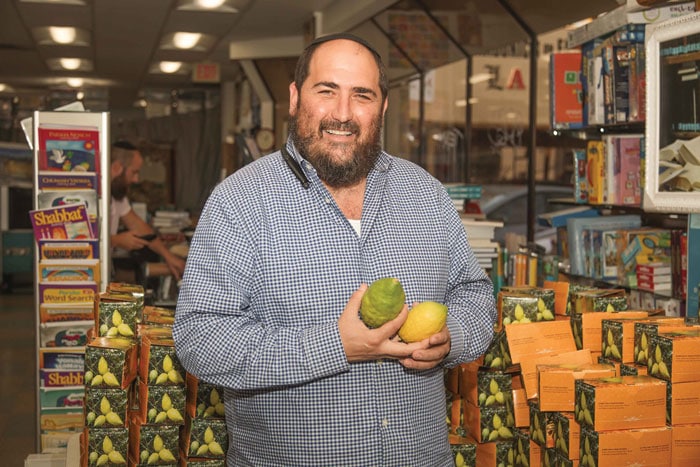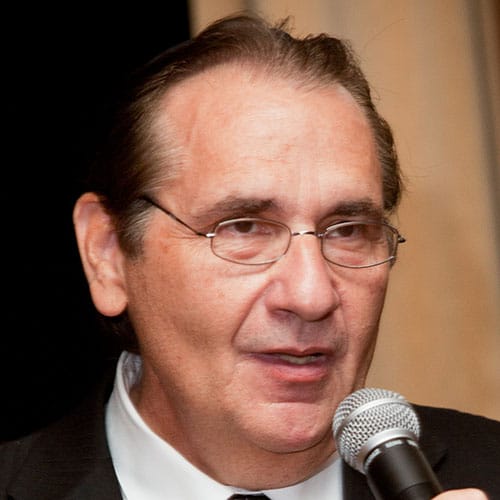 Simcha Kagan (Photo by Harvey Farr)
Simcha Kagan (Photo by Harvey Farr) The phrase “beauty is in the eye of the beholder” has special meaning for Simcha Kagan. The 46-year old owns Atara’s Esrogim and LAesrog.com, through which he sells about 1,800 esrogs every Sukkot. Esrogs (also spelled etrogs) are the crown jewel of the four species, when combined with the lulav (palm frond), hadass (branches of the myrtle tree) and aravah (branches of the willow tree). Together, they form the major religious ritual of the Sukkot holiday.
“There is a Torah commandment which states, ‘And you shall take for yourselves on the first day [of Sukkot], the fruit of the beautiful [citron] tree,’” Kagan said. “People take that commandment very seriously and often go to great lengths to find the perfect etrog [that’s] perfect for them, of course.”
Chabad–Atara’s Judaica Book and Gift Store on Fairfax, where Kagan’s etrog operation is based, displays hundreds of etrogs, each being examined under a high-powered magnifying glass. Kagan, along with etrog expert Shmulie Hauptman, exhibit the concentration of a diamond cutter as they closely scrutinize each of the precious fruit.
“There are a number of factors that determine the desirability of an etrog,” Kagan said. “Shape, color, texture, blemishes and cleanliness are the primary factors that people look for. However, beauty is relative. Some prefer a round-shaped etrog. Others seek an etrog that is more elongated. Often, people want the type of etrog their father used to maintain a family tradition.”
Kagan’s etrog prices, which appear to be the norm, can range from $45 to several hundreds of dollars, which always includes the lulav, hadass and aravah. “I just sold an etrog for $350,” he said. “And we will probably sell more like it.”
Kagan grew up selling lulavs and etrogs while working for his mother, who owned Atara’s Bookstore on Fairfax. Upon her passing, it was sold to Chabad Mid City Bookstore just down the street. “My siblings and I knew that each year we were expected to work in the store during Sukkot selling lulavs and etrogs,” Kagan said. “Our mother needed the help and it was a great way to learn the business.”
While Israel still appears to dominate the etrog growing business, they are also cultivated in Calabria, Italy, Morocco and central California. “There is a Kabbalah (mystical interpretation) that Moses got his etrog from Calabria,” Kagan said. “It is very popular to purchase an etrog grown in Calabria. We sell hundreds that are grown there.”
Kagan noted that next year will be challenging because it will be the “shmita” year. According to Jewish tradition, every seventh year, Jewish-owned land in Israel cannot be worked, and any harvest grown on that land must be given away. “We expect next year most etrogs will come primarily from Calabria, Morocco, California or elsewhere,” he said.
While etrog selling is competitive, according to Kagan it is a very loyal business. “There is an unspoken rule that people buy their etrogs from the same person every year,” Kagan said. “As sellers, we try to sell out each year so we don’t have excess etrogs. Our customers patronize our business each year to assure we will have an etrog to their liking when Sukkot comes the following year.”
A curious aspect of purchasing such a costly fruit is: what do people do with it after the holiday?
A curious aspect of purchasing such a costly fruit is: what do people do with it after the holiday? While Kagan said etrogs don’t rot, many put cloves in them and use it for the weekly Havdalah service. Others make liqueur or jam out of it.
“If you think you are spending a lot of money to just buy a fruit, you’re missing the point,” Kagan said. “Purchasing an etrog along with the lulav, hadass and aravah is the fulfillment of a Torah commandment. “You can’t put a price on that.”























 More news and opinions than at a Shabbat dinner, right in your inbox.
More news and opinions than at a Shabbat dinner, right in your inbox.